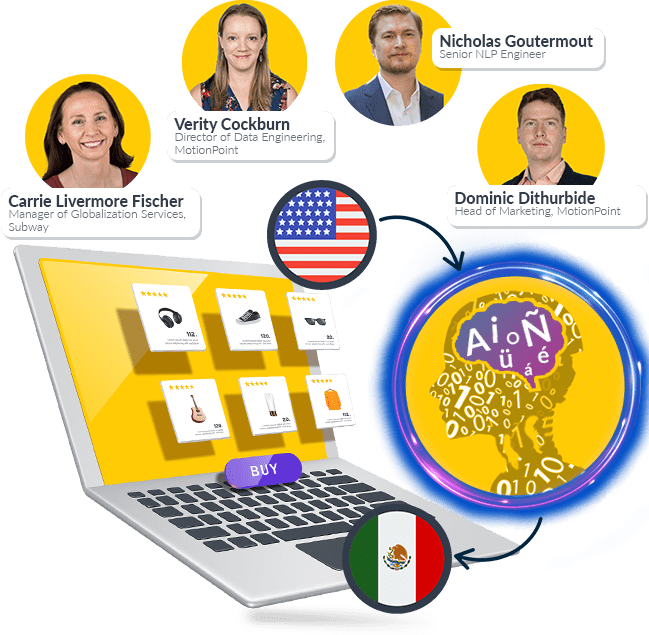The world of online business would be much easier if shoppers behaved identically, regardless of where they lived.
This isn’t the case, of course. Independent research, and MotionPoint’s own decade-plus of data and analysis, has revealed time and again that an online user’s behavior and expectations can be quite different, depending on their home market.
Language is certainly a factor in this; customers in international markets crave experiences in their native language. But to truly connect with these consumers, companies must provide something far important: authenticity, relevance and persuasion.
This ethos transcends translation, and requires a deep knowledge of a market’s culture, shopping habits, technological preferences and more. Not all of this is obvious for newcomers to a particular emerging market.
(For instance: A recent Pitney Bowes study revealed that shoppers in some emerging markets prefer buying products at online marketplaces such as Amazon or Tmall, while other markets prefer buying direct from a retailer’s website. For companies expanding into these markets, not knowing a shopper’s preferred sales channel can create problems. Choosing the “wrong” channel often proves to be a costly mistake.)
So what does this mean for expanding companies? Website content should be unique and relevant to the target market. MotionPoint helps companies create and implement this kind of highly-relevant, customized local content to great effect.
Indeed, investing in highly-localized translations can really pay off. Here are five reasons why it matters more than ever.
#1: Establishing Trust
When most companies launch localized sites in a new market, they’re doing so for the first time, explains Logan Lenz, a Global Online Strategist for MotionPoint’s Global Growth team.
“This suggests their brand is ‘new’ for those international consumers,” he says. “Building credibility and trust is critical, especially in a site’s early days.”
This consumer wariness isn’t an obstacle; it’s an opportunity to woo shoppers with unique, targeted messaging. This content, which displays for first-time visitors, can curb any doubts—and inspire trust and long-term customer loyalty.
MotionPoint helped a UK-based retailer overcome this credibility gap. The company’s objective was to penetrate the U.S. market with a site localized in American English. (Such “English-to-English” localizations also help establish trust, as we recently reported.) The challenge: most American consumers had never heard of this retailer.
We conducted an A/B test, displaying custom localized banners for some American shoppers. These banners displayed in the checkout funnel, and featured messages that built the UK brand’s credibility, and reduced any perceived transactional risk from U.S. consumers.
The results were remarkable. In less than a week, this trust messaging increased checkout rates by 27%, resulting in nearly $200,000 of additional revenue. Based on the banner’s performance, we projected this kind of customized localization could deliver $11.5 million of incremental revenue to the retailer.
“A more subtle, but no less effective, way to build trust is display local contact information in prominent places on the website,” Logan explains. “These market-specific contact points—such as local customer service phone numbers—illustrate a brand’s authenticity, and willingness to interact with local customers.”
Successful brands also list local office and store information, when appropriate.
#2: Driving Unique Behavior
These tactics also work well for directing users to specific promotions and products.
We recently collaborated with a U.S.-based telecom company on ways to boost conversions on its Spanish-language site (which caters to U.S. Hispanics). Our extensive knowledge of the Hispanic market led us to recommend a promotional banner that prominently featured International Calling plans on the Spanish site.
These banners were exclusive additions to the Spanish site.
The campaign was successful. Visits, revenue and Average Order Value increased by 850%, 117% and 43% respectively.
“This kind of smart, custom localization can be applied to ‘markets within markets,’ too,” Logan says. “For an example, let’s take U.S. regions that have large populations of Spanish speakers. We’ve seen these geo-targeted content campaigns yield a 100+% increase in conversions.”
For international markets, companies should also make sure their localized sites feature integration with the regions’ most popular social networks. There are dozens of prominent social networks beyond American borders, and they’re key drivers of traffic to international sites.
As we recently reported, companies that integrate these social networks can win big.
#3: Determining the Best Verbiage
Even the most expertly-crafted translations can sometimes create confusion for readers. When this impacts promotional messaging (where creativity and clarity is especially critical), engagement and conversions can suffer.
“We’ve found lots of value in proactively addressing this with split-testing,” Logan explains. “By testing the effectiveness of specific ‘creative copywriting’ translations against others throughout a site, we’re able to quickly zero in on the most effective messaging for the target market.”
This attention to detail makes a difference. We recently applied one such test to a client’s checkout flow, and determined that slight variations in translations yielded an uptick in conversion rates. Without this localized Conversion Rate Optimization (CRO), our client was missing out on revenue growth.
One fashion retailer saw an 11% increase in sales conversations with a similar CRO initiative. For another telecom company, our localized CRO efforts delivered an increase of 13% to visits to promoted site sections, and a 17% surge in conversions.
We recently collaborated with an airline to refine the promotional messaging on its localized Korean site. The results, post-implementation, were remarkable: high-interest promotional offers saw a 29% leap in engagement and a 69% increase in checkouts.
Other on-site UX customizations can really resonate with specific markets, too. These can include re-sizing and re-coloring of graphical elements (such as buttons), offering intuitive language selection options, and localizing mobile sites for mobile-first markets.
#4: Running Local Promotions
Companies who’ve overcome the hurdle of becoming a “known” and reputable brand in international markets should support their localized sites with marketing and advertising.
We’ve found that an especially effective tactic in these local markets is street marketing—sometimes called guerilla marketing. For instance: hosting local musical events to drive in-store foot traffic, or partnering with a local charity, are powerful ways to create more brand awareness and impressions.
Before, during and after these local events, a company’s localized website acts like a nexus of sorts, promoting the event and providing a post-event destination for satisfied attendees.
“One of our e-commerce clients takes this a step further by finding and empowering brand ambassadors in European countries,” Logan says. “They host fashion shows in their respective communities. The company then posts images and content from the events on its localized websites.
“It puts local communities, and consumers, in the spotlight.”
#5: Soliciting Feedback
Western companies regularly prompt users for feedback on their primary-market English websites, but often fail to do the same on their international sites. That’s a missed opportunity to receive valuable market intelligence.
“Survey responses provide an unedited glimpse into your customers’ perceptions,” Logan advises. “Even if you’re personally not fluent in a market’s preferred language, you can overcome this by having responses translated by your website localization partner.”
The information you’ll glean from these surveys can prove invaluable, Logan says, such as identifying performance gaps—or even cultural gaps—in your website.
MotionPoint offers a proprietary solution to host such localized surveys; dozens of clients have deployed this market research tool. To date, they’ve received more than 5,000 useful comments that led to healthy and positive actions.
“Our research suggests that even when international customers don’t provide feedback, they’re still impressed by the functionality, and are more inclined to trust the website,” Logan says. “It’s a smart and inexpensive tactic to embrace, when localizing a website in a new market.”
The final word: When working with a company like MotionPoint, crafting custom localized content, executing in-language promotional campaigns, and quantifying the lift from those campaigns is easy and inexpensive. Even the most ambitious campaigns MotionPoint oversees are low-cost endeavors.
The insights we uncover—and the results in traffic and revenue we deliver—outweigh the costs.
Last updated on October 29, 2015


